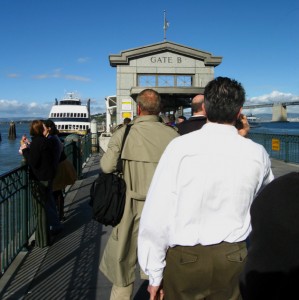 Whether you commute regularly by ferry, bus, train, subway, or trolley—anywhere in the world—or just ride public transportation for pleasure, here are 10 tips to think about and do at all times:
Whether you commute regularly by ferry, bus, train, subway, or trolley—anywhere in the world—or just ride public transportation for pleasure, here are 10 tips to think about and do at all times:
1. Be nice. When the doors open to enter, allow the elderly, disabled, pregnant women, people with infants, children, or luggage to enter ahead of you so you can help hold others back when the “stampede” takes place. Offer these same individuals a seat, assuming you are an able-bodied person who can just as well stand.
2. Don’t be in such a rush. When getting on and off, do not shove or push your way through the masses. Take your time and relax. Barging rarely accomplishes anything and may cause accidents.
3. Have your money and ticket ready. Do not stand in line or in front of the ticket depository fumbling for what you need. At the office or at home, take out your money or ticket and put it in a convenient pocket ahead of time. You’ll be able to pull it out in a flash and not hold up the line.
4. Do you stink? Be aware of your body odor, bad breath, or strong perfume. A friend told me how he sat next to a commuter who took off his shoes to rest his tired feet, and stunk up the entire area. Keep your shoes on until you get home. Don’t eat smelly foods on public transit either. In fact, eating is often not allowed.
5. Keep moving. Do not stop dead to think about where you want to head. Slowly move with the flow of traffic until you choose where you want to go, or step aside while you figure it out. Do not block doorways when you enter. It continues to amaze me how people do not move to the back of a bus where it is less congested. Please, do not blog the entrance!
6. Keep your voice down. Whether speaking to the person next to you or on your cell phone, speak quietly. Did you know in Japan cell phones are not allowed on public transportation? It sure must be a peaceful ride.
When on your cell phone, monitor how loudly you may be speaking. To tone it down, move your phone just a fraction of an inch from your ear when speaking. This will help you to hear your own voice more normally, without the cell phone blocking one ear. Press it back to your ear when listening. Do this back and forth until you are fully aware of how loudly you may be speaking. Also, keep conversations brief when on public transportation. Tell the person you will call them back when you are back to the office or home.
7. No foul language. Never use profane and inappropriate language and within earshot of others in public.
8. Pick up after yourself. Place cups, wrappers, and other garbage in proper trash receptacles. Do not let items blow away without making every effort to catch them for proper disposal.
9. Watch out if you carry a backpack or bags. Be aware of how wide your body becomes when you are wearing a backpack or carrying items over your shoulders or in your arms. Slow down when moving around to prevent whacking someone. When pulling or pushing a wheeled bag, be aware of the space you are taking up. Keep the bag as close to your own body as possible. When you put your stuff on the floor in a crowd, people can’t see below them and will likely trip over your bag, potentially causing injury.
10. No hogging seats. As much as you want to sit alone and have some privacy, forget it when crowds appear. Do not take up more space than your one seat. Placing an item on the seat next to you to make it appear occupied is being selfish and inconsiderate to others who equally deserve to sit as much as you.
BONUS: Parking lots. Forget saving a few steps and time by cutting across the parking lot. You may not realize it, but making cars stop to let you cross slows down traffic and potentially causes accidents. Instead, be good to yourself and others. Use walkways and crosswalks. Besides, studies have shown that such actions don’t really save any significant time to matter.
QUESTION OF THE MONTH: Do you have other commuter pet peeves to share? Send them in the comment section provided. If you live in an area that has unusual ways of doing things you’ve not seen elsewhere, share those differences and what manners or etiquette you think should be displayed versus what you see happening.

Really cool blog and the information was really helpful………………………looking for more.
When seeking more articles on etiquette or on a specific topic, please email us at Info@AdvancedEtiquette.com to see if there is an article on that topic you may have missed seeing or is something we would enjoy writing about. We’re always looking for new ideas.